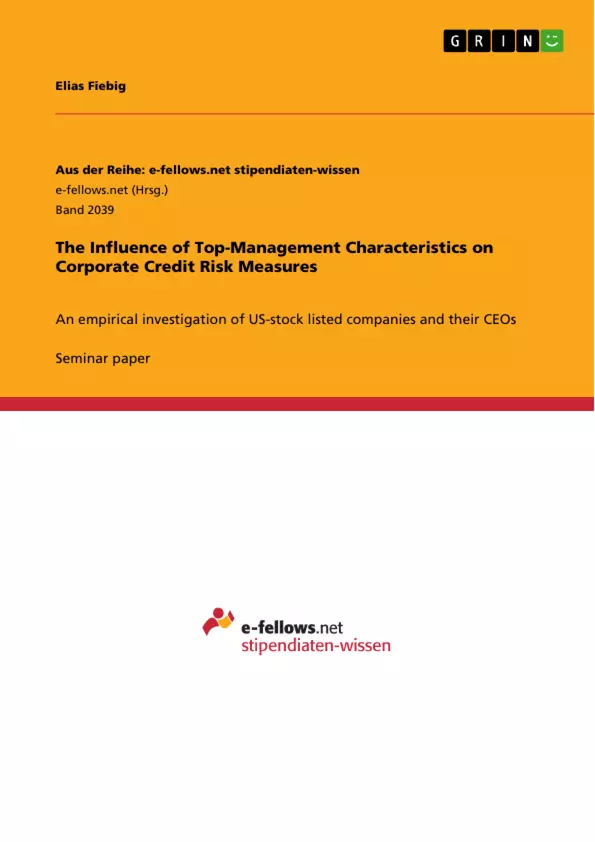Inspired by previous research this paper investigates whether personal CEO characteristics such as age, CEO tenure, gender, MBA and variable salary (%) have a significant effect on firm bankruptcy risk measured using the Altman-Z-Score and the Ohlson-O-Score.
This work is based on literature suggesting (i) CEO managerial characteristics such as overconfidence and optimism lead to higher leverage and increased risk-taking and that (ii) higher levels of debt and increased risk-taking behavior add to the likelihood of corporate financial distress. Using panel data on S&P 500 constituents during 1994-2014 our results provide evidence that CEO age and holding an MBA is positively associated with bankruptcy risk while CEO tenure and variable salary (%) seem to be negatively related to a firm’s propensity to default.
Collectively, our results remain mostly unchanged over various robustness tests employing both pooled OLS and the least squares dummy variable (LSDV) model as well as year, industry and company fixed effects as control variables. Next to significant support that managerial attributes, traits, and style may help to understand organizational outcomes, this project also provides insights how available public information can be used to further explain style effects by disentangling them into separate, measurable impact factors.
Inhaltsverzeichnis (Table of Contents)
- Introduction
- The general influence of CEOs on organizational outcomes
- Empirical evidence on the influence of CEO characteristics
- Relation between CEO characteristics, financial distress and bankruptcy
- Measures of bankruptcy risk
- Altman-Z-Score
- Ohlson-O-Score
- Comparative performance and predictive power
- Definition of explanatory variables and hypotheses
- Data and methodology
- Acquisition of data & sample selection
- Methodology
- Econometric setup
- Control variables
- Empirical analysis and findings
- Description of data & sample
- Empirical results of multivariate analysis
- Robustness testing and sub-sample validation
- Conclusion
- Limitations and suggestions for further research
Zielsetzung und Themenschwerpunkte (Objectives and Key Themes)
This paper examines the impact of CEO characteristics on corporate credit risk, specifically investigating whether personal characteristics such as age, tenure, gender, MBA, and variable salary influence the probability of firm bankruptcy. It aims to contribute to the understanding of how managerial traits and styles can affect organizational outcomes and how publicly available information can be used to disentangle these style effects.
- Influence of CEO characteristics on corporate credit risk
- Impact of personal traits, such as age, tenure, gender, and education, on firm bankruptcy risk
- Relationship between CEO characteristics and risk-taking behavior
- Empirical analysis of firm behavior using the Altman-Z-Score and Ohlson-O-Score models
- Application of econometric techniques to assess the impact of CEO characteristics on financial distress
Zusammenfassung der Kapitel (Chapter Summaries)
- Introduction: This section introduces the research question and provides an overview of the paper's purpose, highlighting the importance of understanding the influence of CEO characteristics on corporate credit risk. It also briefly discusses the theoretical framework and the methodology employed.
- The general influence of CEOs on organizational outcomes: This chapter provides a broad literature review on the influence of CEOs and their personal characteristics on organizational outcomes. It examines the empirical evidence on the relationship between CEO characteristics and financial distress and bankruptcy.
- Measures of bankruptcy risk: This section delves into the specific measures of bankruptcy risk used in the paper, namely the Altman-Z-Score and the Ohlson-O-Score. It explains the models, their interpretations, and their predictive power.
- Definition of explanatory variables and hypotheses: This chapter defines the explanatory variables used in the study, including CEO age, tenure, gender, MBA, and variable salary. It also formulates the research hypotheses based on prior research and the expected relationships between these variables and corporate credit risk.
- Data and methodology: This section outlines the data acquisition process and sample selection. It provides details about the data source, the period covered, and the criteria used to identify the sample firms and CEOs. It also explains the econometric setup and the control variables used in the analysis.
- Empirical analysis and findings: This chapter presents the results of the multivariate analysis, examining the relationship between CEO characteristics and corporate credit risk using the Altman-Z-Score and Ohlson-O-Score. The chapter also includes robustness tests and sub-sample validations to ensure the reliability of the findings.
Schlüsselwörter (Keywords)
The primary focus of this research centers around the influence of CEO characteristics on corporate credit risk, utilizing the Altman-Z-Score and Ohlson-O-Score models for analysis. Key themes include managerial attributes, risk-taking behavior, corporate governance, financial distress prediction, and empirical analysis of firm behavior.
- Citation du texte
- Elias Fiebig (Auteur), 2016, The Influence of Top-Management Characteristics on Corporate Credit Risk Measures, Munich, GRIN Verlag, https://www.grin.com/document/337384



